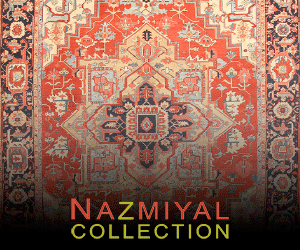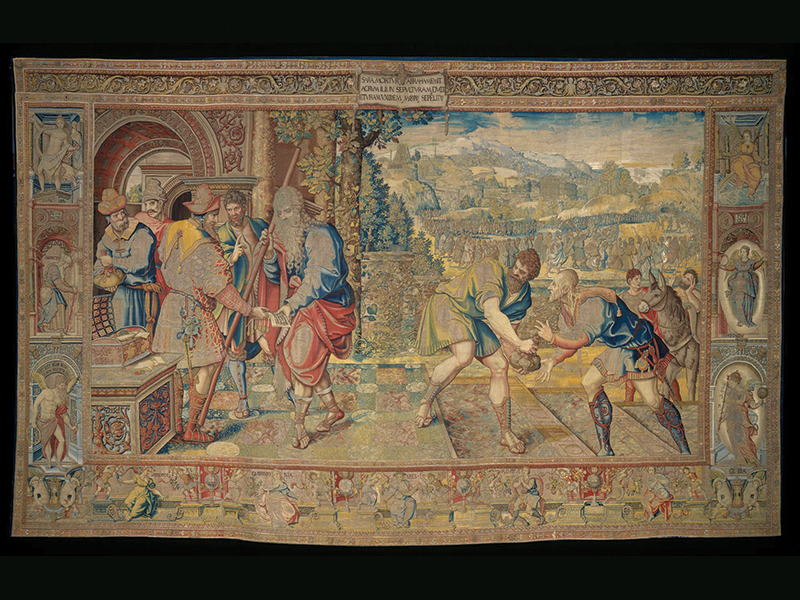The European Art Form of the 16th - 19th Centuries Is the Hot New Wall Decor Choice of the 21st Century
There is a saying, “what’s old is new again.” Fashion works in cycles, and what is popular at a certain time might fall out of favor for a while, only to be rediscovered some time later, and celebrated once again as the trendy “new” item of the moment.
Such is the case with the antique tapestry, which is all the rage now in the Summer of 2024, appearing in shelter magazines like Architectural Digest and Elle Decor, on endless lists of what’s trending within in-home decor, on the websites and social media postings of prominent interior designers, and on the walls of more and more buyers around the United States and Europe.
The antique tapestry was for centuries the ultimate luxury item and status symbol of the royalty and the elite of Europe, with England’s King Henry VIII famously having over 2,500 of them in his collection. His palace at Hampton Court was adorned with multiple sets of tapestries, including a set based on the Biblical patriarch, Abraham, and another set based on the Roman emperor, Julius Caesar. King Henry was so obsessed with tapestries, that according to some reports, he purportedly bankrupted his country (twice!) to pay for more and more of these custom weavings!
WHAT IS AN ANTIQUE TAPESTRY, AND WHY WERE THEY STATUS SYMBOLS?
In Europe in the 1500s through the 1800s, antique tapestries were perhaps the single most exalted luxury item that someone could have. They were the stuff of kings and royalty, and of the wealthy elite. Similar to the way that, in the current day, the rich and famous will have the most elaborate mansions as status symbols, along with the latest exotic cars and mega-yachts, the rich and powerful of that era in Europe had majestic castles, and adorned their castle walls with grand tapestries.
Antique tapestries are flat-woven decorative textiles, woven by hand with wool and silk, and in some cases with gold, silver, and metallic thread. These tapestries were made by custom order by some of the finest weavers, workshops, and ateliers of Europe, and primarily from those located in France, Belgium, and the Netherlands.
Tapestries were hung on the walls of the castles of kings, princes, dukes, and the wealthy class, and served multiple purposes. The tapestries provided insulation for the castle walls, serving as a layer of protection for the interior of the home from the cold, drafty, or rainy weather outside the castle walls. They served as a form of reflective illumination, in that the tapestries with gold, silver, or metallic threads in them would provide glinting reflections of the interior lamps and other light sources in the castles, giving them a heightened glowing effect. They were aesthetically beautiful, displaying the artistry of some of the finest weavers in Europe.
In many cases, these tapestries served the additional purpose of conveying subtle (or not-so-subtle) messages about their owners. Some of this messaging would come from the size and scale of the tapestries, with the biggest, most grandiose, and most richly appointed tapestries conveying the highest status.
Additionally, the identity of the artist, especially if that artist was one of the most esteemed in Europe, like Peter Paul Rubens or Ian Raes, would amplify the power and status conveyed by the tapestries.
Beyond that, the subject matter of the tapestries was telling, with many of them depicting subjects ranging from Biblical scenes to Historical scenes, and from Mythological scenes to Verdure scenes.
BIBLICAL AND HISTORICAL TAPESTRIES
Two of the styles that were the most popular in the 15th, 16th, 17th and 18th centuries were the Biblical and Historical Tapestries. As their titles imply, these tapestries depicted Biblical or Historical scenes. Popular biblical subjects included Old Testament figures, like Moses and like the patriarchs, Abraham, Isaac and Jacob.
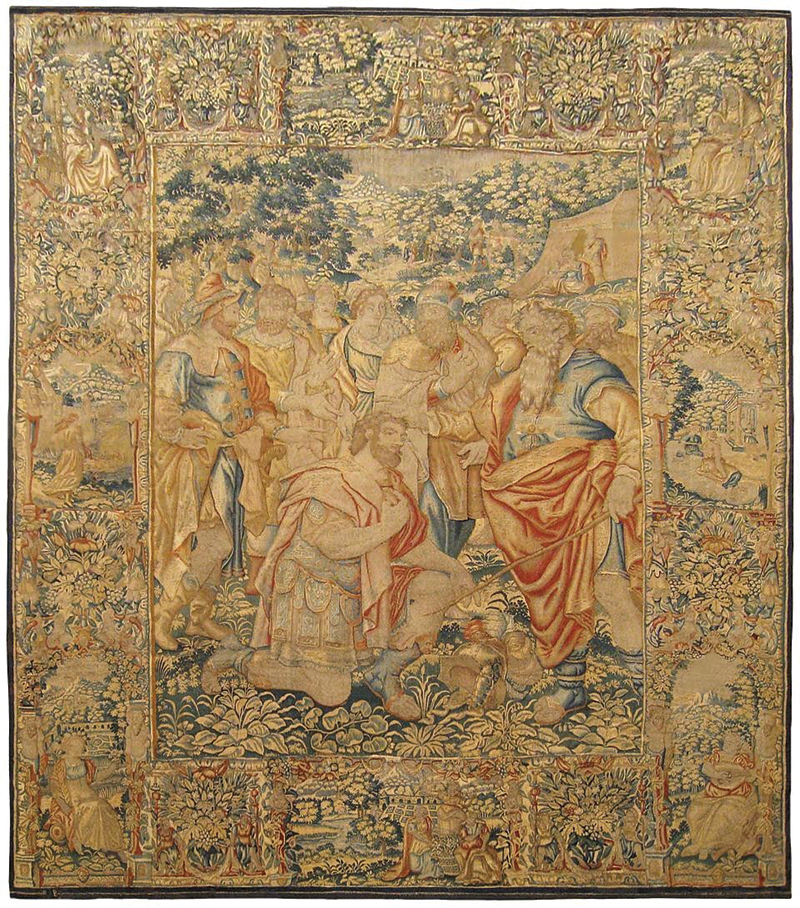
Tapestry #27859, 16th Century, Brussels ‘Moses & Joshua’ – 11’0” x 8’5”
Also popular were New Testament tapestries, including depictions of Jesus and the Apostles, Joseph and Mary, and others.
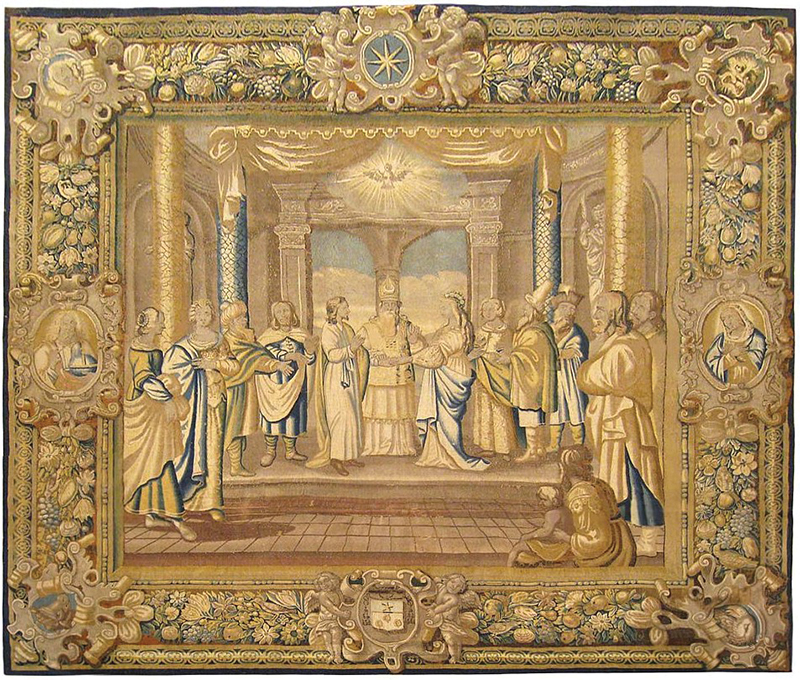
Tapestry #27468, 17th Century, French ‘Marriage of Joseph & Mary’ – 11’0” x 11’0”
Historical tapestries were also extremely popular during this time, depicting various kings, queens, famous wars, and certain important historical moments.
The depiction of these famous Biblical and Historical figures, scenes, and moments in these grand tapestries served multiple purposes. They attested to the religious or national loyalties of the owners; i.e., a religious scene for a king who was loyal to or observant of his religion, or a historical scene of a king’s past ancestor who helped to establish his nation and was a founder of his royal line.
Additionally, they would display the skill of the weavers, for rendering a well-known figure in a particularly regal or dynamic setting, or with a memorable stance or facial expression.
Furthermore, these tapestries spoke to the cultural moment or zeitgeist of their particular eras, and in the castles of certain members of the ruling elite, could take on added layers of meaning, and convey powerful messages about their owners.
HENRY VIII AND THE JULIUS CAESAR AND ABRAHAM TAPESTRIES
The Bibilical and Historical Tapestry styles discussed above had a certain level of cultural meaning in and of themselves, as they depicted important religious figures or historical moments or personalities. In the case of England’s King Henry VIII, who had the grandest collection of tapestries in history, they also became an important tool for his royal messaging.
In King Henry VIII’s reign, he had six wives, but did not succeed in having a male heir with any of them from whom he could safely carry on his kingdom. He divorced his first three wives by annulment, breaking England’s connection with the Roman Catholic Church in the process, and bringing about the Protestant Reformation.
This process of breaking away from the established form of Catholicism and creating his country’s own new form of Christianity was a pivotal moment for King Henry, and in support of that enormous societal shift, he looked to connect his own image with those of two past biblical and historical icons of seismic cultural change, the patriarch Abraham, and the Roman emperor, Julius Caesar.
To cement his connection to those two figures, King Henry commissioned two of the most important sets of tapestries in history, the Story of Abraham series, relating the journeys of Abraham, who broke away from polytheism and brought about monotheism, and the Julius Caesar series, with Caesar’s arc from being a member of the Roman senate, to being an outcast, to coming back and conquering Rome and taking it to new previously unimaginable new heights. (See lede image.)
While the Story of Abraham series is still intact, and can be seen to this day at Hampton Court in England, the Julius Caesar series were sold off or otherwise lost to time.
One of the only Julius Caesar tapestries that is still extant is currently in our own collection, and depicts the fateful moment in which Julius Caesar crosses the Rubicon river, establishing himself as the new leader of Rome, and going on to become the greatest and most famous emperor in Roman history.
In likening himself to these world-renowned figures, Abraham and Julius Caesar, King Henry VIII set himself up as being the next in the line of these famous iconoclasts, giving both biblical and historical significance and connection to himself as the rightful and quasi-divine monarch of the English throne. It also gave greater credence to his ability and authority to break away from past religious conventions of the Roman Catholic Church, and redirect England’s religion in the direction of his choosing.
While the Biblical and Historical Tapestry styles were extremely popular, and were used by kings and the wealthy as status symbols and as subliminal messaging tools, two other styles that were also very popular, not just with kings and the elite, but also with a broader audience, were the Mythological and Verdure Tapestry styles.
Mythological tapestries told the stories of various deities and figures from Greek and Roman mythology, including Zeus, Hermes, Diana, Aphrodite, and Persephone. Verdure tapestries envisioned nature scenes, with forests, trees, bushes, flowers, birds, and other wildlife.
Mythological tapestries were often grandiose and other-worldly, depicting figures and scenes that are in some sense recognizable as being of this earth, but also feature dragons, demons, or other beings that connect this world to the far-off mythological realm.
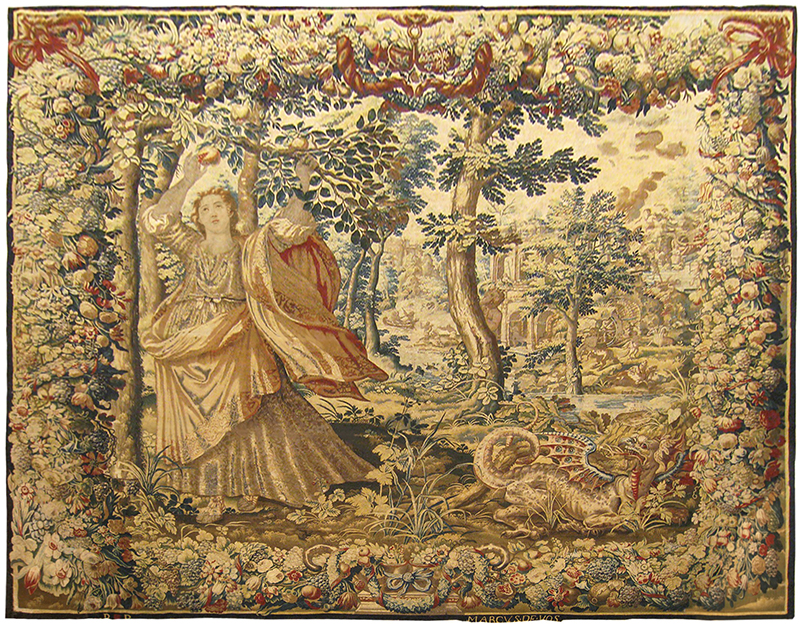
Tapestry #24800, 17th Century, Brussels ‘Myth of Persephone’ – 12’0” x 13’0”
One such piece is the Myth of Persephone, envisioning the eponymous deity, Persephone (or Proserpine) plucking a pomegranate from a tree while standing alone amid demons and dragons, as she ushers in the Spring season for her short time on earth, before being doomed to the rest of the year in the underworld.
On the other extreme, the Verdure tapestry was all about the earth and nature, and became increasingly popular and in demand as European society became more city-oriented in the 17th to 19th centuries. People were increasingly removed from nature, and these Verdure tapestries became the preferred way to capture a perfect, idyllic vision of the natural world, and bring it with them into their homes and cottages.
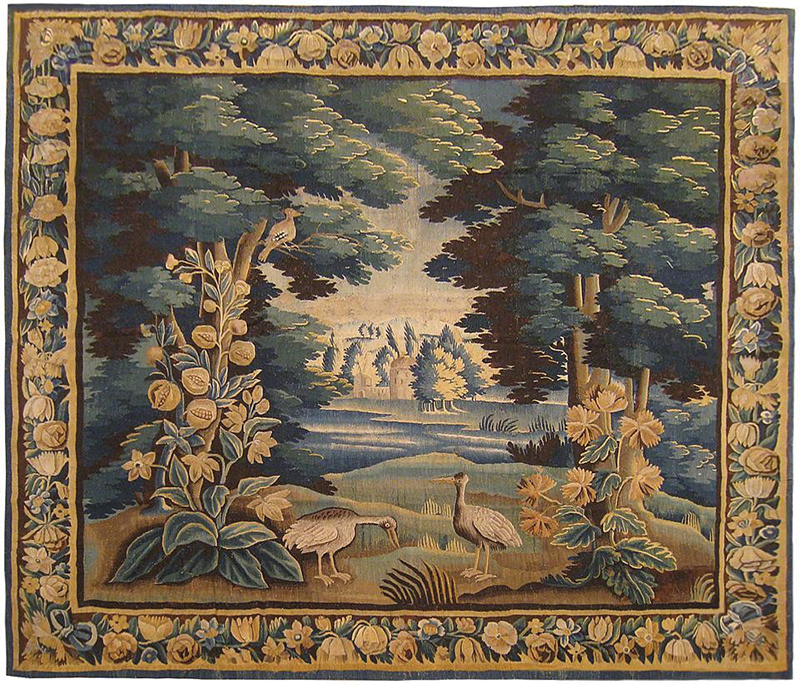
Tapestry #29153, 17th Century, Flemish Verdure Landscape – 9’6” x 9’9”
Many people in England and throughout Europe still held mythological figures and stories very close to home, both in their education about past cultures and stories, as well as in their personal beliefs. Mythology, like religion, offered a way of understanding certain aspects of the world that seemed to be beyond nature.
In some cases, the Mythological and Verdure styles would merge, as mythological figures would be depicted in a realistic forest environment, grounding the otherworldly deities within the observable world of nature.
One such tapestry is from a series based on the female deity Diana the Huntress (pictured below), in which Diana seen is in a realistic forest setting, reviewing the spoils of her latest hunt with her attendants.
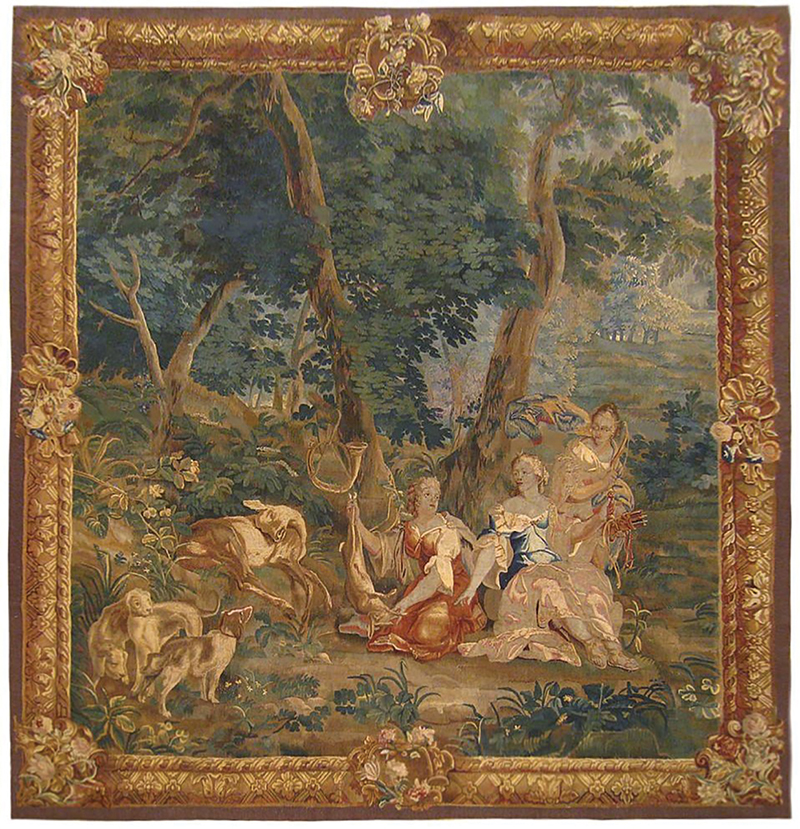
Tapestry #26214, 18th Century, Brussels ‘Diana the Huntress’ – 9’0” x 8’0”
Tapestries like this, which took a figure from mythology and lore, and placed her firmly in a natural environment that might exist not far from a person’s home, became increasingly popular with the European audience, especially in the 17th, 18th and 19th centuries, when wealth became more widely distributed in Europe. As part of that societal shift, more people were able to have enough wealth to buy homes, and adorn those homes with smaller versions of the grand tapestries that their kings and leaders had established as status symbols in the preceding centuries.
For a larger discussion of this societal trend, and a more detailed analysis of several different sub-categories within the Verdure tapestry style, see our previous InAntiques article published in the Fall 2022 issue of RUG INSIDER Magazine.
While society has changed significantly since these different types of tapestries were all the rage in Europe, tapestries have once again emerged at the forefront of the fashion and interior design worlds, and have been rediscovered as a must-have form of wall decor that more and more people are seeking out for their homes.
They might have a different cultural cache today than they did in the days of King Henry VIII and some of the other kings and leaders who helped to usher in the heyday of tapestry popularity in the 16th – 19th centuries, but the fact that they have reemerged naturally attest their staying power, to the incredible artistry and beauty that they have, and to the masterful weaving that went into their creation.
All of the tapestry styles enumerated in this article are increasingly popular in the United States, Europe, and beyond. The world’s largest selection of these tapestries can be found in a variety of sizes can be found in a variety of sizes and designs at pgny.com.
IMAGES COURTESY OF PGNY




